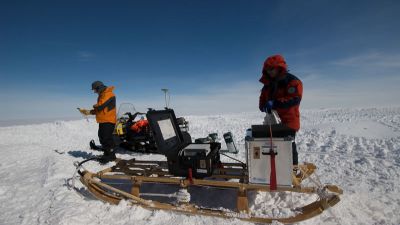
Ice Rise and Ice Shelves: Understanding Ice Dynamics
Ice rises are islands covered by grounded ice several hundred meters thick and characterized by a local ice flow sticking out within an ice shelf. These islands buttress the ice flow from the ice shelf and slow the speed of the ice flow down; causing these ice rises to have a flow regime that is radically different from the rest of the ice shelf.
During November-December 2010 a geophysical survey of one such prominent ice rise (Derwael ice rise) was carried out within the Roi Baudouin ice shelf by a team of glaciologists (Frank Pattyn, ULB and Kenichi Matsuoka, NPI).
The purpose of the survey was to characterize the flow and the thickness of the ice rise and the ice shelf. To find out more about the stability of the ice rise, the glaciologists further investigated the grounding line dynamics (contact of the ice rise with the ice shelf and the ocean).
They carried out a GPS survey to precisely map the ice divide (highest points of the ice rise) and carried out a series of radar measurements across the divide and the grounding line using both low and high frequency radars (2 and 400 MHz, respectively).
- The first radar type enabled the scientists to determine ice thickness and to identify isochronal layers (i.e. the layers of ice that originated during the same period) within the ice. The age of the various ice layers can then be used in an effort to better understand the ice flow through time.
- The second radar identifies spatial variations in surface accumulation. Again, knowing where the ice accumulates is crucial in understanding the ice flow and movement in time.
The divide profiles clearly showed upwarping of isochronal layers due to the high ice viscosity under the divide. This is what glaciologists call the “Raymond effect”.
Preliminary model experiments carried out in the field demonstrated that the ice flow of the ice rise should be stable for a few thousand years.
Further analysis of radar data will define the bedrock type (rock and/or sediment). By combining radar layer analysis and modeling, the scientists will have a clearer view of the dynamics of the grounding line.
This research helps achieve more accurate models integrating the complex phenomena related to the flow of ice towards the ocean. Thanks to these models, the scientists are able to more accurately predict possible sea level rises, which is crucial to all of us.
Picture: Frank Pattyn and Kenichi Matsuoka in the field - © International Polar Foundation - René Robert
